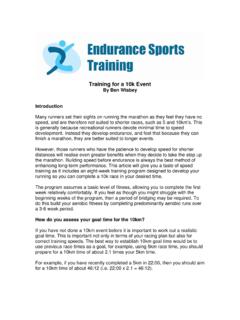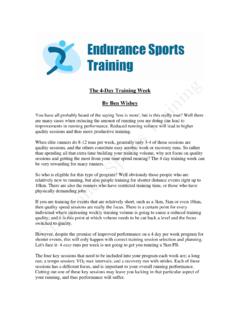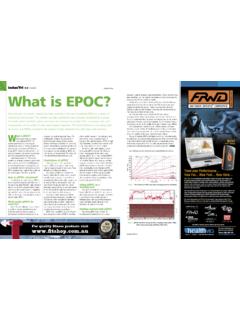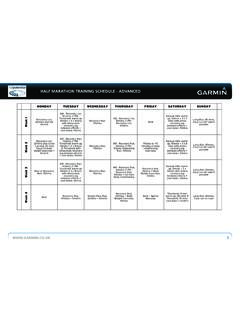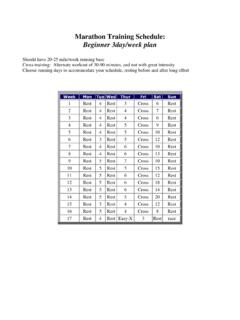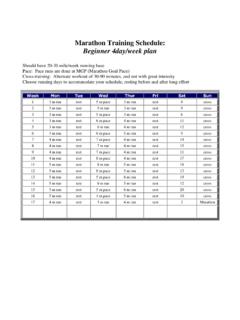Transcription of Novice marathon training program - Endurance …
1 marathon training program for Your First marathon By Ben Wisbey Coach Endurance Sports training Endurance Sports training offers individually written training programs for runners of all abilities. For more information please go to or contact Ben on training for your first marathon is always a daunting task. You are heading into the unknown. You know that both training and the marathon itself will be hard, but how hard? First time marathon runners commonly want answers to the following three questions: What is the quantity of training required? How long should the long runs be? How many months is the ideal marathon preparation? I will attempt to answer these questions in this article as well as outlining a marathon training program for the first time marathon runner.
2 Developing your marathon Plan marathon training is focused on improving your aerobic Endurance and strength Endurance . These are the two key aspects of achieving your marathon goal. If you are new to running I would suggest that you build through to a 5km, 10km and then a half marathon before attempting the full marathon . marathon preparation requires a sufficient training background in order to cope with the training volumes, and therefore having some half marathon training under your belt will be very beneficial. For those individuals stepping up to the marathon from this background, it is still recommended that you allow at least 18-20 weeks of consistent running in your preparation. The training program below represents an 18 week marathon preparation.
3 The beginning of the training program assumes that you capable of comfortably completing 90 minutes of easy running. If this is not the case, gradually build up your long run to the 90 minute mark before commencing the training program outlined in this article. Keep in mind that the program accompanying this article is a generic Novice marathon training program . While is provides a good framework for which to follow, you will need to fine tune this program based on your individual needs. If you need assistance with your training program please visit training program Description Warm-up and Cooldown All training runs should include a warm-up period at the start of the session and a cool down period at the finish of the session. These periods should be counted in the overall run duration as it is still time spent running.
4 Jog at a very low intensity for your warm-up and cool down. The warm-up should be at least 10-12 minutes long, and the cool down at least 10 minutes long. During the latter part of the warm up you should complete some drills as a form of dynamic stretching; these include high knees, butt kicks, bounding and short stride outs. Session Types Long Runs A marathon is conducted over a long duration at a relatively low intensity. Long runs are therefore the key to your marathon success. Your long runs should be done over a hilly course and include a combination of soft and hard surfaces. As the event draws closer, gradually start making your long runs less hilly and run a greater portion of them on hard terrain, so that you get used to running on the road. Ideally you will want to build up your long run so that you complete one to two 36km runs.
5 Your long runs should be conducted at a moderate intensity. The pace of your long runs should range from 30seconds slower than goal race pace to goal marathon pace. Many first time marathon runners are capable of holding marathon goal pace throughout their long runs as it is the muscular fatigue of the marathon distance itself that is the limitation on race day, and not their running intensity. All training session lengths are specified by duration rather than distance. Distance is a crucial factor in your long runs however, so for long runs the target distance is specified. The duration is also included as a guide for these sessions. If you take a longer or shorter period of time to complete the scheduled distance this is okay. Recovery Runs Recovery runs are easy, short jogs aimed at promoting recovery while still providing aerobic enhancement.
6 They should be done at a low intensity over flat natural terrain. Don t worry about the pace of these runs; they should only ever be nice and easy. It can be beneficial to include some short surges in a recovery run, to loosen up your muscles and joints. Medium Long / Aerobic Runs Medium long runs are the sessions used to supplement the Sunday long run. Medium long runs are similar to long runs in terms of desired running pace. They should be completed over hilly courses. Strides Strides are simply a pickup or surge to an increased running speed. They are used to enhance your neuromuscular running performance. Strides to about 5km race pace should be interspersed with several minutes of easy running. Be sure to do strides on flat terrain, such as an oval.
7 Tempo Runs Tempo runs are used to boost your strength Endurance and anaerobic threshold. This allows increased speed to be maintained, as well as reducing muscular fatigue at your desired marathon pace. The intervals in these sessions should be conducted on a flat or slightly undulating course, and should only be started after a thorough warm up has been completed. The efforts should be done at about 10-15km race pace (or the maximal pace you could sustain for 1 hour) and a steady pace should be maintained. The recovery periods between intervals should be an easy jog. Cruise Intervals Cruise intervals are similar to tempo intervals in that they are completed at a firm intensity that is around anaerobic threshold intensity. The difference between the two types of intervals is that cruise intervals are significantly shorter and conducted at a slightly higher intensity, such as 8-10km race pace.
8 Strength Endurance Runs Strength Endurance is one of the keys to lasting the distance of a marathon and remaining fatigue resistant for as long as possible. The best method of developing strength Endurance is through hill efforts- this is also a great method of increasing running economy. The hill efforts should be done on a long hill of moderate grade and the intensity should be firm/hard. Attempt to maintain relatively long strides on the ascent as this will foster a greater improvement in strength due to greater force production. Once you reach the top of the uphill effort, simply turn and jog back down before immediately starting your next effort. The hill chosen for this session should not be too steep; the ideal hill grade is between 4-6%. Steep hills do not lead to greater gain.
9 The goal is to ensure that you get strength gains that transfer to flat running- a steep hill will require more vertical leg drive than horizontal. On the days that require a tempo period prior to the hill efforts, simply add in a flat tempo period at a firm intensity. Attempt to get to the bottom of the hill at the completion of your tempo period, so you are able to immediately start your first hill effort. VO2 Sessions These intense sessions are used to improve VO2 max and maximal sustainable running speed. These characteristics may not seem so important for a first time marathon runner. By improving these aspects of your performance, however, you will improve your ability over shorter race distances. This in turn means that your marathon pace becomes a lower percentage of your top running speed, thus making it easier to maintain marathon pace from both a physiological and biomechanical view point.
10 VO2 sessions are best completed at a track or oval over the specified distance, with intervals being at about 3-5km race pace. The recovery between each effort should be an easy jog. These sessions are very demanding on the body. Understanding the program Layout All specified session durations (and distances) include the warm-up and cool down. Where the program specifies a total duration that appears greater than total time required for the warm-up, cooldown and main part of the session, make up the remainder of the time with easy aerobic running. Meeting your individual Goals The program outlined here is a generic program that may need to be customised to fit around your own individual schedule. The program can easily be adjusted with modifications made to the weekly outline and the training load as required.

